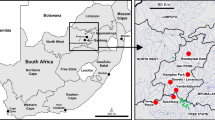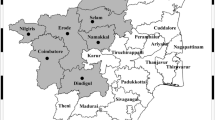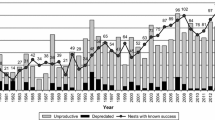Abstract
Northern Cardinal eggs from six neighborhoods near Washington DC were analyzed for organochlorine pesticides and PCBs. All compounds were detected more frequently and at higher concentrations in more heavily urbanized neighborhoods. DDT (mostly as p,pʹ-DDE) was detected in all neighborhoods. p,pʹ-DDT was typically 0.5‒16 ng/g (ww) in most suburban neighborhoods but was not detected (< 0.1 ng/g) in more rural areas; however, p,pʹ-DDT was 127‒1130 ng/g in eggs from two suburban Maryland nests and comprised 65.7% of total p,pʹ-DDT isomers in the most contaminated sample, indicating recent exposure to un-weathered DDT. Total chlordane (sum of 5 compounds) was 2‒70 ng/g; concentrations were greatest in older suburban neighborhoods. Total PCB (sum of detected congeners) was < 5‒21 ng/g. Congener patterns were similar in all neighborhoods and resembled those typical of weathered mixtures. Results indicate that wildlife remains exposed to low concentrations of legacy contaminants in suburban neighborhoods and that cardinal eggs can be used to monitor localized contamination.




Similar content being viewed by others
Change history
03 July 2018
The original version of this article contained a mistake. Author name in the text citation and reference in section should be Maldonado et al (2016), it was incorrectly spelled as Maldinado et al (2015).
References
Agency for Toxic Substances and Disease Registry (ATSDR) (1994) Toxicological profile for chlordane. U.S. Department of Health and Human Services, Public Health Service, Atlanta, GA
Aguilar A (1984) Relationships of DDE/DDT in marine mammals to the chronology of DDT input into the ecosystem. Can J Fish Aquat Sci 21:840–844
Bekarian N, Payne-Sturges D, Edmondson S, Chism B, Woodruff TJ (2006) Use of point-of-sale data to track usage patterns of residential pesticides: methodology development. Environ Health 5:15–26
Beyer WN, Meador JP (eds) (2011) Environmental contaminants in biota, 2nd edn. CRC Press, Boca Raton, FL
Bienkowski B (2014) DDT still killing birds in Michigan. Environ Health News July 28. https://www.scientificamerican.com/article/ddt-still-killing-birds-in-michigan/. Accessed 11 Jun 2017
Bishop CA, Koster MD, Chek AA, Husssell DJT, Jock K (1995) Chlorinated hydrocarbons and mercury in sediments, red-winged blackbirds (Agelaius phoeniceus) and tree swallows (Tachycineta bicolor) from wetlands in the Great Lakes–St. Lawrence River basin. Environ Toxicol Chem 14:491–501
Blus LJ (2011) DDT, DDD, and DDT in birds. In: Beyer WN, Meador JP (eds) Environmental contaminants in biota, 2nd edn. CRC Press, Boca Raton, pp 425–444
Blus LJ, Wiemeyer SN, Bunck CM (1997) Clarification of effects of DDE on shell thickness, size, mass, and shape of avian eggs. Environ Pollut 95:67–74
Bouwman H, Viloen IM, Quinn LP, Polder A (2013) Halogenated pollutants in terrestrial and aquatic bird eggs: converging patterns of pollutant profiles, and impacts and risks from high levels. Environ Res 126:240–253
Chen D, Hale RC, Watts BD, La Guardia MJ, Harvey E, Mojica EK (2010) Species-specific accumulation of polybrominated diphenyl ether flame retardants in birds of prey from the Chesapeake Bay region, USA. Environ Pollut 158:1883–1889
Darnerud PO (2003) Toxic effects of brominated flame retardants in man and in wildlife. Environ Internat 29:841–853
Echols KR, Tillitt DE, Nichols JW, Secord AL, McCarty JP (2004) Accumulation of PCB congeners in nestling Tree Swallows (Tachycineta bicolor) on the Hudson River, New York. Environ Sci Technol 38:6240–6246
Echols KE, Peterman PH, Hinck JE, Orazio CE (2013) Polybrominated diphenyl ether metabolism in field collected fish from the Gila River, Arizona, USA—levels, possible sources, and patterns. Chemosphere 90:20–27
Eens M, Jaspers VLB, Van den Steen E, Bateson M, Carette C, Clergeau P, Cotantini D, Dolenec Z, Elliott JE, Flux J, Gwinner H, Halbrook RS, Heeb P, Mazgajski TD, Moksnes A, Polo V, Soler JJ, Sinclair R, Veiga JP, Williams TD, Covaci A, Pinxten R (2013) Can starling eggs be useful as a biomonitoring tool to study organohalogenated contaminants on a worldwide scale? Eviron Internat 51:141–149
Elliott JE, Bishop CA (2011) Cyclodiene and other organochlorine pesticides in birds. In: Beyer WN, Meador JP (eds) Environmental contaminants in biota, 2nd edn. CRC Press, Boca Raton, pp 447–475
Elliott JE, Brogan J, Lee SL, Drouillard KG, Elliott KH (2015) PBDEs and other POPs in urban birds of prey partly explained by trophic level and carbon source. Sci Tot Environ 524–525:157–165
Farmahin R, Wu D, Crump D, Herve JC, ́ Jones SP, Hahn ME, Karchner SI, Giesy JP, Bursian SJ, Zwiernik J, Kennedy MJ SW (2012) Sequence and in vitro function of chicken, ring-necked pheasant, and Japanese quail AHR1 predict in vivo sensitivity to dioxins. Environ Sci Technol 46:2967–2975
Gao F, Luo X-J, Yang Z-F, Wang X-M, Mai B-X (2009) Brominated flame retardants, polychlorinated biphenyls, and organochlorine pesticides in bird eggs from the Yellow River Delta, North China. Environ Sci Technol 43:6956–6962
Halkin SL, Linville SU (1999) Northern cardinal (Cardinal cardinalis). In: Poole A, Gill F (eds) The birds of North America, no. 440. Academy of Natural Sciences, Philadelphia, and American Ornithologists Union, Washington, DC
Harris ML, Elliott JE (2011) Effects of polychlorinated biphenyls, dibenzo-p-dioxins and dibnezofurans, and polybrominated diphenyl ethers in wild birds. In: Beyer WN, Meador JP (eds) Environmental contaminants in biota, 2nd edn. CRC Press, Boca Raton, pp 477–528
Harris ML, Wilson LK, Elliott JE, Bishop CA, Tomlin AD, Menning KV (2000) Transfer of DDT and metabolites from fruit orchard soils to American Robins (Turdus migratorius) twenty years after agricultural use of DDT in Canada. Arch Environ Contam Toxicol 39:205–220
Hebert CE, Weseloh DV, Kot L, Glooschenko V (1994) Organochlorine contaminants in a terrestrial foodweb on the Niagara Peninsula, Ontario, Canada 1987–89. Arch Environ Contam Toxicol 26:356–366
Hinck JE, Norstrom RJ, Orazio CE, Schmitt CJ, Tillitt DE (2009) Persistence of organochlorine chemical residues in fish from the Tombigbee River (Alabama, USA): continuing risk to wildlife from a former DDT manufacturing facility. Environ Pollut 157:1207–1219
Hwang JH, Park JY, Park HJ, Bak SM, Hirano M, Iwata H, Park YS, Kim EY (2016) Ecological factors drive natural selection pressure of avian aryl hydrocarbon receptor 1 genotypes. Sci Rep 6:27526
Kolpin DW, Furlong ET, Meyer MT, Thurman EM, Zaugg SD, Barber LB, Buxton HT (2002) Pharmaceuticals, hormones, and other organic wastewater contaminants in U.S. streams, 1999–2000: a national reconnaissance. Environ Sci Technol 36:1202–1211
Mackintosh SA, Dodder NG, Shaul NJ, Aluwihare LI, Maruya KA, Chivers SJ, Danil K, Weller DW, Hoh E (2016) Newly identified DDT-related compounds accumulating in Southern California bottlenose dolphins. Environ Sci Technol 50:12129–12137
Maldinado AR, Mora MA, Sericano JI (2016) Seasonal differences in contaminant accumulation in neotropical migrant and resident songbirds. Arch Environ Contam Toxicol 72:39–49
Mora MA, Durgin B, Hudson LB, Jones E (2016) Temporal and latiitudinal trends of p,pʹ-DDE in eggs and carcasses of North American birds from 1980 to 2015. Environ Toxicol Chem 35:1340–1348
Nowell LH, Moran PW, Gilliom RJ, Calhoun DL, Ingersoll CG, Kemble NE, Kuivila KM, Phillips PJ (2013) Contaminants in stream sediments from seven United States metropolitan areas: part I: distribution in relation to urbanization. Arch Environ Contam Toxicol 64:32–51
Peterman PH, Feltz KP, Orazio CE, Echols KR (2006) Basic alumina flash chromatographic separation of bulk ortho-PCBs from non-ortho-PCBs, PBDEs, PCDFs, PCDDs, PCDTs, OCPs and PCTs. Organohalogen Compd 68:2458–2461
Peterman PH, Feltz KP, Echols KR, Orazio CE (2009) A miniaturized S-X3 flash GPC cleanup column. In: Pittsburgh Analytical Conference (PittCon) 2009, Chicago, IL
Priha E, Hellman S, Sorvari J (2005) PCB contamination from polysulphide sealants in residential areas-exposure and risk assessment. Chemosphere 59:537–543
Rattner BA, Wiemeyer SN, Blus LJ (2016) Retrospective: adjusting contaminant concentrations in bird eggs to account for moisture and lipid loss during their incubation. Bull Environ Contam Toxicol 97:2–3
Reynolds KD, Rainwater TR, Scollon EJ, Sathe SS, Adair BM, Dixon KR, Cobb GP, McMurry ST (2001) Accumulation of DDT and mercury in Prothonotary Warblers (Protonotaria citrea) foraging in a heterogeneously contaminated environment. Environ Toxicol Chem 20:2901–2909
Roux K, Marra PP (2007) The presence and impact of environmental lead in passerine birds along an urban to rural land-use gradient. Arch Environ Contam Toxicol 53:261–268
Scheifler R, Coeurdassier M, Morilhat C, Bernard N, Faivre B, Flicoteaux P, Giraudoux P, Noel M, Piotte P, Rieffel D, de Vaufleury A, Badot P-M (2006) Lead concentrations in feathers and blood of common blackbirds (Turdus merula) and in earthworms inhabiting unpolluted and moderately polluted urban areas. Sci Tot Environ 371:197–205
Schmitt CJ, Echols KR, Peterman PH, Orazio CE, Grim C, Tan S, Diggs NE, Marra PP (2018) Organochlorine chemicals in northern cardinal eggs from suburban. U.S. Geological Survey data release, Washington, DC. https://doi.org/10.5066/F76W999M
Secord AL, McCarty JP, Echols KR, Meadows JC, Gale RW, Tillitt DE (1999) Polychlorinated biphenyls and 2,3,7,8-tetrachlorodibenzo-p-dioxin equivalents in tree swallows from the upper Hudson River, New York State. Environ Toxicol Chem 18:2519–2525
Stapleton HM, Dodder NG, Offenberg JH, Schantz MM, Wise SA (2005) Polybrominated diphenyl ethers in house dust and clothes dryer lint. Environ Sci Technol 39:925–931
U.S. Environmental Protection Agency (USEPA) (2017) Superfund site: Beltsville Agricultural Research Center (USDA), Beltsville, MD. https://www.cumulis.epa.gov/supercpad/cursites/csitinfo.cfm?id=0300415. Accessed 26 Sept 2017
U.S. Environmental Protection Agency (USEPA) (2018a) DDT-a brief history an statues. https://www.epa.gov/ingredients-used-pesticide-products/ddt-brief-history-and-status. Accessed 03 Jul 2018
U.S. Environmental Protection Agency (USEPA) (2018b) Polychlorinated biphenyls. https://www.epa.gov/pcbs/learn-about-polychlorinated-biphenyls-pcbs. Accessed 03 Jul 2018
van den Berg M, Birnbaum L, Bosveld AT, Brunström B, Cook P, Feeley M, Giesy JP, Hanberg A, Hasegawa R, Kennedy SW, Kubiak T, Larsen JC, van Leeuwen FX, Liem AK, Nolt C, Peterson RE, Poellinger L, Safe S, Schrenk D, Tillitt D, Tysklind M, Younes M, Waern F, Zacharewski T (1998) Toxic equivalency factors (TEFs) for PCBs, PCDDs, PCDFs for humans and wildlife. Environ Health Perspect 106:775–792
Van den Steen E, Dauwe T, Covaci A, Jaspers VLB, Pinxten R, Eens M (2006) Within- and among-clutch variation of organohalogenated contaminants in eggs of great tits (Parus major). Environ Pollut 144:355–359
Vermeer K, Reynolds LM (1970) Organochlorine residues in aquatic birds in the Canadian prairie provinces. Can Field Natur 84:117–130
Acknowledgements
This study was jointly supported by the U.S. Geological Survey (USGS) and the Smithsonian Institution, the latter through a Smithsonian Endowment Grant to S. Tan and C. Grim. Collections were in accordance with US Fish and Wildlife Service permits under the auspices of the Neighborhood Nestwatch, a citizen-science program operated through the Smithsonian Migratory Bird Center at the National Zoo (http://www.sio.si.edu/Nestwatch), and were approved by the Institutional Animal Care and Use Committee of the Smithsonian National Zoological Park. M. Hooper and D. Tillitt (USGS) reviewed all or parts of earlier versions of the paper. K. Feltz (USGS) prepared the samples for analysis, C. Chojnacki (USGS) prepared the map, and R. Tillitt (USGS) compiled the data for release. Any use of trade, product, or firm names is for information purposes only and does not imply endorsement by the U.S. government.
Author information
Authors and Affiliations
Corresponding author
Rights and permissions
About this article
Cite this article
Schmitt, C.J., Echols, K.R., Peterman, P.H. et al. Organochlorine Chemical Residues in Northern Cardinal (Cardinalis cardinalis) Eggs from Greater Washington, DC USA. Bull Environ Contam Toxicol 100, 741–747 (2018). https://doi.org/10.1007/s00128-018-2357-x
Received:
Accepted:
Published:
Issue Date:
DOI: https://doi.org/10.1007/s00128-018-2357-x




